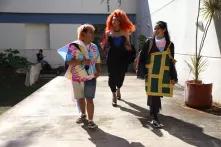The legacy of this ancient culture is at risk, which is why he decided to create a photo library to prevent them from falling into oblivion.

Text: Abraham Bote
Photos: various authors
Through photography, Pedro Alonso Dzidz Tuz, a young graduate in Social Anthropology, resists and fights against oblivion, against the official history that tries to erase the Mayan legacy of Tuzik, Quintana Roo.
A year ago he helped create the community's first photo library, a space that houses a collection of more than 100 physical and some digital photographs that serve as a witness to the past, present and future of the Mayan village. All this inside an ancestral Mayan dwelling.
The photographer explains the project, which aims to document and disseminate the historical memory of Tuzik through audiovisual material. The project began when he was a student, when he traveled to Chiapas for a field internship and visited the Na Bolom photo library in San Cristóbal de las Casas, where he observed images of Lacandon Mayans.
“I developed this idea and thought I would like to do this in my community," he said. This idea became a reality with his thesis project.
Thanks to a call from the National Institute of Indigenous Peoples (INPI), he was able to consolidate this photo library, and the institute helped him to build the Mayan dwelling that houses the photographs.
The images have been rescued from anthropologists, and researchers who documented the community over the years, from 1936 to 1994, as well as from teachers who came to teach in the Mayan village. Incidentally, the Mayan culture is the second largest in Mexico.
He also found photographs in libraries during his anthropological wanderings.
The photos are of places, and portraits of people, including some who have not been identified; With this, the people of the community can reflect on the passage of time, learn about aspects of their place of origin of which they were unaware, and see places that have changed or no longer exist.
Seeing photos of his community, where he is originally from, at times when he was yet to be born, was surprising.
“We can see how the landscape and the clothing have been changing, and make a historical assessment”.
Photographs, testimonies of the past
But how do you remember a loved one that you never knew and about whom there is no evidence, no photographs to prove that he or she passed through this existential plane?" he asks.
As a child, Pedro Alonso always heard stories about his military great-grandfather, Raymundo Dzidz, but he had never seen a photograph of him. He never allowed himself to be photographed and the few that were available were destroyed over the years.
In 2018, by chance, he visited the Caste War Museum, located in Tihosuco, Felipe Carrillo Puerto, Quintana Roo, where he found a photograph of this relative. This photo is now exhibited in the Tuzik photo library.
This feeling, of (re)meeting a person you thought was lost, is something wonderful, which is why this photographic exhibition represents an attempt to preserve memories. “Seeing our ancestors, and discovering our similarities and our differences, is to know where you come from and feel proud," he stresses.
They have also portrayed people from the community so that the new generations will know them in later years. “Sometimes we lack identity and don't know where we come from," he insists.
Fight against oblivion
With the photo library, they fight against oblivion, against the little importance accorded to the history of the Mayan communities, their inhabitants, their landscapes and their environment. Grandfathers and grandmothers die; knowledge is not transmitted, and people leave the communities. There are no traces of its existence.
Therefore, the photos make it possible to know more about this legacy and contrast this knowledge with the official narrative. His academic and university education was fundamental for the creation of the project because it was thanks to this that he was able to travel to other places that helped him to make this dream come true.
“My studies freed me from my insecurities. I learned how to manage the project, get it out in the open and research it thoroughly," he says.
For Dzidz Tuz, this initiative also represents a fight against authoritarianism and adultcentrism; This is a project driven by "chamacos", young people from the same community. Rebels of the people.
They have also collected life stories, such as that of Santiago Chab, a character not recognized by official history, who was a master violinist of the Maya Paax, the longest-lived musical entity of the State of Quintana Roo, considered intangible cultural heritage.
The documentation of the community's historical memory has not yet been completed; it is planned to maintain constant research in the town to learn from the villagers about the culture, traditions and history of the community.
This photo story was produced with the support of the Global Support for Democracy Unit of the Heinrich-Böll-Stiftung European Union. They are part of the dossier "Youth & democracy in Latin America. Young voices on the rise".







